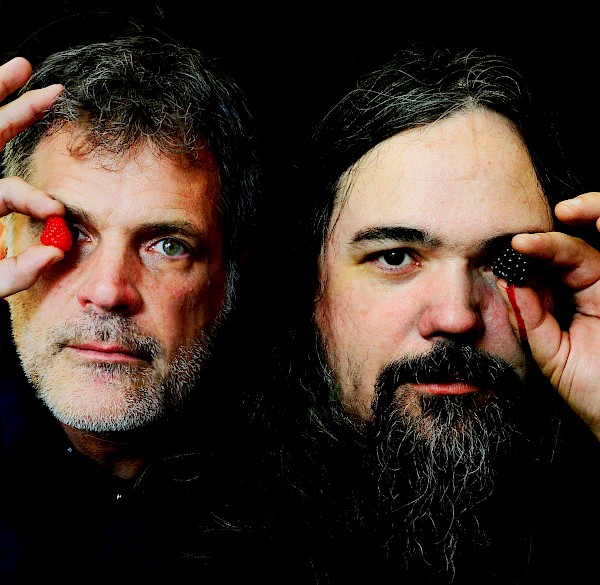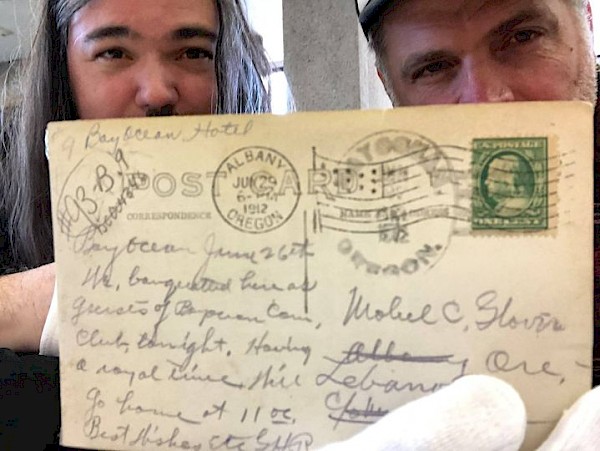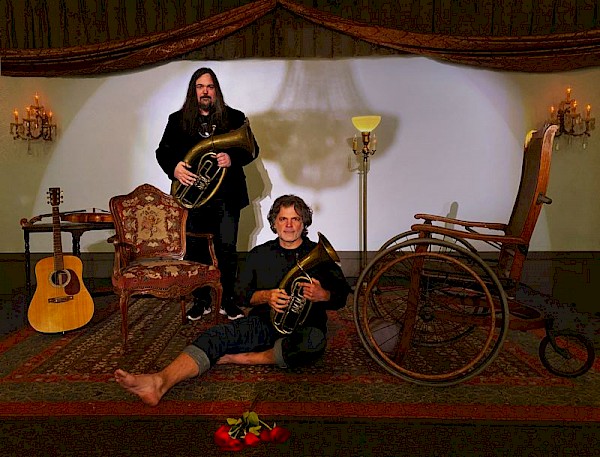 Wonderly's Jim Brunberg and Ben LandsverkIf ever there was a time for an informed and inspired historical perspective on humanity’s hubris and oddities, this must certainly be it. Jim Brunberg and Ben Landsverk of Portland duo Wonderly took some time out from famously scoring podcast themes (The Daily), TV shows (BoJack Horseman) and indie films to create a series of songs and short films of their own. Originally called True & Tall Tales of the Pacific NorthWeird, the five-song EP due out January 29 is now aptly renamed Story We Tell Vol. 1. Wonderly collected odd stories from the region in collaboration with authors, live-action filmmakers, animators, native storytellers, artists, and local music legends like soul singer Ural Thomas to smartly package and present actual Pacific Northwest legends in the form of narrative music videos.
Wonderly's Jim Brunberg and Ben LandsverkIf ever there was a time for an informed and inspired historical perspective on humanity’s hubris and oddities, this must certainly be it. Jim Brunberg and Ben Landsverk of Portland duo Wonderly took some time out from famously scoring podcast themes (The Daily), TV shows (BoJack Horseman) and indie films to create a series of songs and short films of their own. Originally called True & Tall Tales of the Pacific NorthWeird, the five-song EP due out January 29 is now aptly renamed Story We Tell Vol. 1. Wonderly collected odd stories from the region in collaboration with authors, live-action filmmakers, animators, native storytellers, artists, and local music legends like soul singer Ural Thomas to smartly package and present actual Pacific Northwest legends in the form of narrative music videos.
In a state with more ghost towns than any other in the nation, the seemingly tall but true and haunting tale of Bayocean is the rise and fall of an Oregon coastal city and its most passionate advocate, resident and pharmacist Francis Drake Mitchell, whose desperation to save it lead to his insanity.
“We started working on the song as part of a songwriting challenge from my friend Ritchie Young [of Loch Lomond],” Landsverk explains.
“Yeah, we had written one about D.B. Cooper and other weird stuff,” Brunberg interjects, “and somehow we got into a conversation with him on what’s the weirdest thing about Oregon.”
“Right, we challenged him to write one about the Holy Rollers and he ended up telling us the story of Bayocean,” Landsverk recalls. “I grew up in Portland and I had never heard of it before.”
Bayocean was intended to be a resort town—the Atlantic City of the West Coast—resting on a four-mile spit on Tillamook Bay. It boasted, among other amenities, a hotel, dance hall, movie theater, and a heated saltwater swimming pool with a wave machine, built right on the beach with balconies for spectators and bands to play for the protected swimmers.
The only way for visitors to reach Bayocean was by a yacht of the same name, which sailed weekly to and from Portland. In rough weather, the trip could be frightening as passengers crossed the Columbia River into the mouth of an equally tempestuous Tillamook Bay. To smooth the journey, residents hired the U.S. Army Corps of Engineers to build a protective barrier. The corps strongly suggested two jetties, but at the cost of over $2 million with residents footing half the bill, they went fatally cheap with only one—a mistake that changed the current and began eroding the sand that the whole town was built upon.
 Wonderly, white gloves and all, researching Bayocean at the Oregon Historical SocietyTo research and gather these sources, Landsverk and Brunberg went to the Oregon Historical Society and became members. “We were in a little back room with our white gloves going through the archives and looking at old pictures and documents,” Landverk says, “and that's when we found Ida and Francis and their story.”
Wonderly, white gloves and all, researching Bayocean at the Oregon Historical SocietyTo research and gather these sources, Landsverk and Brunberg went to the Oregon Historical Society and became members. “We were in a little back room with our white gloves going through the archives and looking at old pictures and documents,” Landverk says, “and that's when we found Ida and Francis and their story.”
“Bayocean,” as told in song through the undaunted viewpoint of Francis Mitchell, includes the lyrics: “Sand, earth and till, will bend to my will, the ocean is a beast that I can tame.” Mitchell, the stubborn madman that he had become by the 1950s, could often be found trying to rebuild the spit with a shovel and a wheelbarrow—a poignantly futile image of man’s attempt to rule natural forces.
Native Tillamooks had likely warned Bayocean families about the seasonally recurring erosion. Their oral traditions tell of a god-like transformational figure, As’aiyahatl (South Wind), who balances the world by changing people, animals and remaking the landscape. South Wind often broke and remade the sandbar from spit into island. In November 1952, a storm tore open a half-mile wide gap where the ocean rushed in, rendering Bayocean an island once more.
From 1906 to the 1960s, time and diverted tides swallowed the natatorium and last standing house. Remnants were ravaged by winter storms and the rest was bulldozed in the ’70s. In very short order, Bayocean went from “the Playground of the Pacific Northwest” to “the town that fell into the sea.” Francis Mitchell’s wife Ida died of a stroke in 1953 and Francis was committed to the Oregon State Mental Hospital in Salem, where he later died on July 25, 1965 at the age of 95. (The morbidly curious may wish to consult PDXHistory.com for more backstory.)
Brunberg brought the archival images to one of his favorite fine artists, Karen Wippich, formerly of Portland, now in New Mexico. “She is driven by historical events and historical pictures and creates paintings around them,” Brunberg says. “She does amazing work focusing on the heart and the undercurrents rather than documentary-style art. Sort of emotional paint-overs of old pictures, putting them against the backdrop, and juxtaposing historical figures and details in a way that’s really beautiful.” Wippich happened to be experimenting with trying to animate in Photoshop at the time and the creation of the video fell into place. Wonderly supplied her with 50 or 60 archival images captured on an iPhone and Wippich fleshed it out with more scoured off the internet.
 The construction of the music for “Bayocean” has its own little backstory as Brunberg tells it: “We call ourselves a ‘workshop orchestra.’ Ben is virtuosic on viola [and] bass, and I'm usually the guitar player, but we both play just about everything just passably enough to build orchestras in the studio. Me on horns, both of us on keys and percussion. We usually write together on whatever weird instrument we have in our hands. ‘Bayocean,’ oddly enough, was first sketched out on ukulele and drums.”
The construction of the music for “Bayocean” has its own little backstory as Brunberg tells it: “We call ourselves a ‘workshop orchestra.’ Ben is virtuosic on viola [and] bass, and I'm usually the guitar player, but we both play just about everything just passably enough to build orchestras in the studio. Me on horns, both of us on keys and percussion. We usually write together on whatever weird instrument we have in our hands. ‘Bayocean,’ oddly enough, was first sketched out on ukulele and drums.”
“Bayocean” is a cross-genre mini-symphony where the banjo and “heave-ho” rhythm evokes the pioneering vision of something being built, while the mournful, sea-sparkling song title refrains sound like dreams dashed by the consuming waves. It reminds the listener of perhaps an outtake from Midlake's The Trials of Van Occupanther or a just little left of Sufjan Stevens' Illinois in its historical telling.
“Yes! Totally!” says Brunberg, agreeing on the sonic hot take. “Banjo gives it some historical out-west feel. But we also were shooting for some upscale ‘modern minded’ tinges that would reflect the ‘new world’ aspects of what Bayocean’s founders were going for when they built the fancy playground for Portland’s elite—it could only be reached by sea!”
 Of course, at the outset, Wonderly had a show planned, but as with all shows and venues, they were thwarted by the pandemic. “Ben and I were going to play and bring a cast of musicians and we were going to screen the films and play live alongside them and in between them and have some other weird Northwest stuff happen,” Brunberg laments. “The live event component was canned, but we didn't want to lose the timeliness so we decided to release them digitally for people to enjoy during lockdown in a kind of double EP format. This is Vol. 1 and Vol. 2 will be coming out sometime next year.”
Of course, at the outset, Wonderly had a show planned, but as with all shows and venues, they were thwarted by the pandemic. “Ben and I were going to play and bring a cast of musicians and we were going to screen the films and play live alongside them and in between them and have some other weird Northwest stuff happen,” Brunberg laments. “The live event component was canned, but we didn't want to lose the timeliness so we decided to release them digitally for people to enjoy during lockdown in a kind of double EP format. This is Vol. 1 and Vol. 2 will be coming out sometime next year.”
Other songs and corresponding films on Story We Tell Vol. 1 are already garnering small acclaim. “‘November 1971’ is a totally different live-action style. We ended up feeling really good about it and submitted it to a bunch of festivals, just on a lark,” Brunberg admits. But then it ended up as a Best Action Film award finalist and with Brunberg winning Best Oregon Director at the Austin Micro Short Film Festival.
On a similar note, the Hollywood Theatre made Brunberg and Landsverk part of their developing filmmakers group. Wonderly are hoping to have a future event there but are trying to navigate venue calendars, which are strangely full with the backlog of rescheduled concerts—something Brunberg is intimately familiar with as a founder of Mississippi Studios, Polaris Hall and Revolution Hall as well as a leader of the Independent Venue Coalition of Oregon's effort to save local stages.
“There’s going to be some kind of a Renaissance, an intense resurgence of live events where there’s going to be amazing stuff happening every night,” Brunberg says. “So we’re wondering, should we look at November to do these, like our original event? Or should we look at 2022 to do it in the spring? You don’t have an event for music that you’ve already released. That’s part of the reason we’re releasing it in small volumes as opposed to like, ‘Well, here it all is, world!’”
In the meantime, Wonderly offers a handful of sonic fables with regional flavor, but without being preachy, and in the case of “Bayocean,” there’s a gentle takeaway.
“It’s a documented climate change tragedy. Without hitting people over the head with it, we were trying to show that people can make huge decisions that greatly influence their environment immediately and in the big picture and it has tragic results sometimes,” Brunberg explains. “This is a sort of cautionary tale; it’s meant to be subtle, but leave people thinking, ‘Wow, what happened there?’ Hopefully someone visiting that place will be a 12-year-old future engineer who helps come up with some solutions for the rising ocean.”




